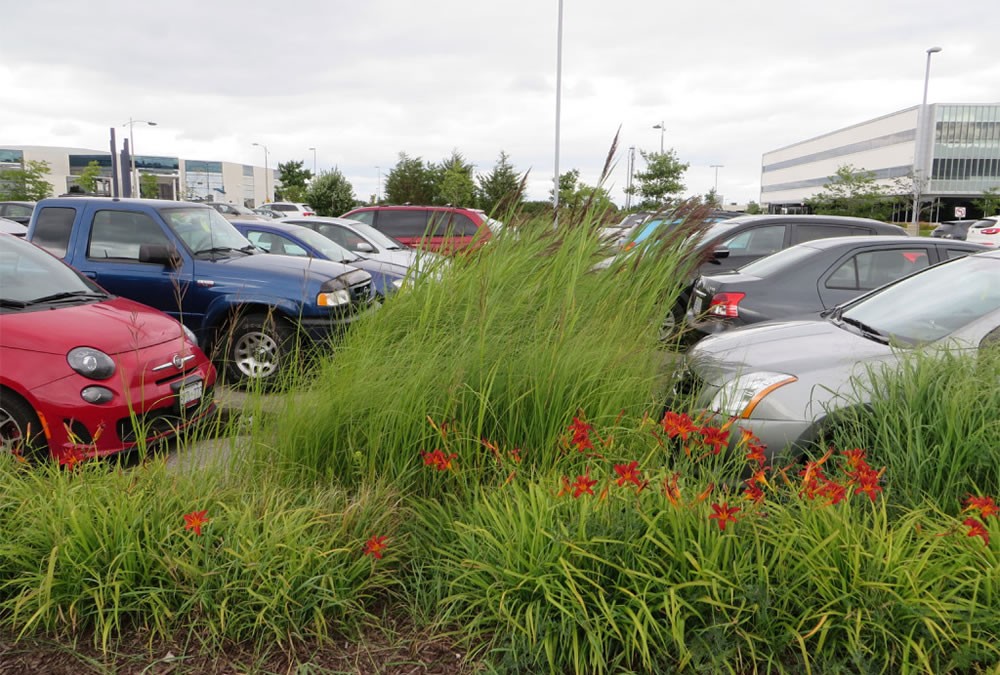As far back as the early 1990s, the Ontario Ministry of Environment and Climate Change (MOECC) has been publicly professing support for managing rain where it falls and reducing runoff volumes –most recently in an interpretation bulletin published in 2015. The reality is that development has continued across the province using primarily conventional, end of pipe, stormwater management. This is about to change.
The MOECC and consultants at Aquafor Beech have been working since 2016 on a Low Impact Development (LID) Stormwater Management Guidance manual that will set clear requirements for controlling runoff volumes. The manual lays out how new development, redevelopment and linear (road) projects will need to maintain pre-development hydrology. Managing runoff from up to the 90th percentile storm will be required following a clear hierarchy:
- Priority 1: Infiltration, evapotranspiration, rainwater harvesting and reuse
- Priority 2: Filtration and release using LID measures
- Priority 3: End-of-pipe, such as oil/grit separators and stormwater ponds
No longer will source controls be merely encouraged – they will be an integral part of municipal stormwater systems.
Although this is not a policy change, it will be a change in practice for many municipalities and developers. Fortunately, there is a wealth of experience for municipalities to draw on. A few currently available resources include:
- Training programs offered by Credit Valley Conservation, Toronto and Region Conservation Authority, and Lake Simcoe and Region Conservation Authority on the design, construction, and maintenance of LID.
- Low Impact Development Treatment Train Tool for the planning and design of LID developed by the three CAs above.
- Demonstration projects and case studies across the province produced by CVC, TRCA, LSRCA, and REEP Green Solutions.
- Resources for municipal policies and programs to support green infrastructure implementation (guidelines by LSRCA, Soak it up! Toolkit by Green Communities Canada).
- RAIN Community Solutions and Depave Paradise community engagement programs for green infrastructure and stormwater runoff.
The manual has already received input from a diverse stakeholder advisory committee including municipal engineers, developers, consultants, ministry staff, and nonprofits. The manual is near completion and is expected to be posted on the Environmental Registry this spring and to come into force shortly afterwards.
There is no reason for municipalities to wait to begin implementing the new approach to stormwater management. The direction from the province is clear, the technology is available, and implementation can begin immediately.
Some municipalities are well ahead of the curve. The City of Kitchener has understood for years the importance of controlling runoff volumes because of the need to recharge groundwater aquifers, and in 2016 approved an Integrated Stormwater Management Master Plan which embodies the principles of the provincial guidance. The City of Thunder Bay has been implementing LID retrofits across the city as directed by its 2016 Stormwater Management Plan for Sustainable Surface Water Management. In the fall of 2017, we highlighted in the Umbrella Bulletin projects in Ajax and London that were testing out rain gardens in parks and rights of way. And the Region of Peel has undertaken some significant projects, including permeable sidewalks and underground infiltration chambers along the high traffic, arterial Mississauga Road.
For some municipalities, this change may seem daunting. But the benefits, including cleaner recreational waters, drinking water, and aquatic habitats, resiliency to extreme weather, reduced urban heat island effect, increased habitat, increased economic activity, and more liveable cities, will far outweigh the costs.
To quote the forthcoming manual:
“To truly protect Ontario’s water resources, the natural and human environments and preserve the ecological services already provided by our existing natural systems, these practices [low impact development and green infrastructure] must be integrated into everyday urban forms, into the very fabric of the community. In this way, a complete and healthy community is formed whereby the very features which support the human inhabitants (roads, parks, grassed areas, sidewalks) become the very elements that protect the existing hydrologic features and function, create habitat, and make a community more livable and sustainable.”

